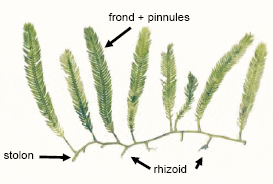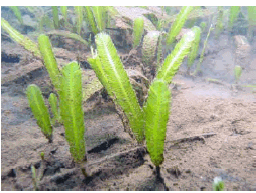What is Caulerpa taxifolia?

Caulerpa taxifolia (Caulerpa) is a bright green, fast growing alga that originates from tropical areas of the Indo-Pacific, including northern Australia. It is not native to New South Wales (NSW) (except Lord Howe Island) and was first identified in mainland coastal locations in 2000. The first infestations probably came from aquaria as, prior to it being banned, Caulerpa had been a popular aquarium plant in Australia for many years. Caulerpa favours sheltered waters, such as estuaries and coastal lakes. Despite being a tropical marine alga, Caulerpa has the ability to establish and proliferate in cooler waters like those in NSW.
Why is it a problem?
Caulerpa is considered a pest in NSW because when introduced to new areas it can grow rapidly and densely to cover large areas of the seabed. This may reduce the availability of habitats, such as bare sand and native seagrasses, for native species. Caulerpa can also have adverse effects on native cockles. Caulerpa is currently present in several coastal lakes and estuaries in NSW (check the I&I NSW website for the current distribution of Caulerpa). In NSW Caulerpa taxifolia is listed as a Class 1 noxious species under the Fisheries Management Act 1994, and possession and sale are illegal.
How to identify Caulerpa
- Caulerpa has light to bright green feather-like fronds that are attached to a main stem (stolon) that runs along the ground.
- The stolon can measure over 1 m long and has root-like structures called rhizoids to attach to the substrate.
- Caulerpa can be distinguished from other similar species by the characteristic branching pattern of the pinnules (small lateral branches on the fronds), which attach directly opposite each other on the fronds.
What is Industry & Investment NSW doing to control Caulerpa?

In 2009 I&I NSW released an updated Control Plan, which aims to limit further spread of Caulerpa and reduce the impacts of existing populations. This will be achieved through vector management, compliance and education, as well as the control and treatment of high priority areas and continued monitoring and research.
I&I NSW will continue to implement fishing closures to minimise the risk of Caulerpa being spread to new locations from both recreational and commercial netting activities.
Initial research on control methods for Caulerpa identified the application of salt as the most useful control tool, and many hundreds of tonnes have been applied to infestations in NSW. However, many factors can reduce the feasibility of this treatment technique, including the depth of the infestation, the area of the seabed that requires treatment and the extent of other native seagrass species intermingled with Caulerpa. Consequently, salt is now only used in limited circumstances.

What you can do to help
Caulerpa can be spread by fishing and boating activities. Propellers and anchors can cut the fragments into small pieces which can then colonise new areas. Any fragments of Caulerpa that end up on your fishing gear, nets or anchor well can remain viable for days. To help stop the spread of Caulerpa it is important to inspect your gear for fragments, and any found should be put in a sealed plastic bag and disposed of in a rubbish bin.
You can also get involved in local community groups that may be actively helping to control the spread of Caulerpa. Cooperative efforts have been beneficial in several areas, such as Wallagoot Lake. Contact your local council or I&I NSW Fisheries Office for information on activities in your area.

Caulerpa research in NSW
- A lot of research has been done, and continues, on Caulerpa in NSW. Some of the outcomes include:
- Native seagrass species Posidonia australis (Posidonia) and Zostera capricorni (Zostera) have shown resilience to Caulerpa, although small beds of Zostera may be vulnerable to the alga, particular in the presence of other disturbances.
- The numbers and species of fish and invertebrates can vary between Caulerpa and native seagrass beds, and native herbivores have been found to consume relatively little Caulerpa.
- There appear to be at least two genetic strains of Caulerpa in NSW, which indicates two separate incursions.


